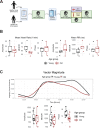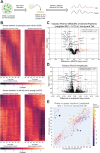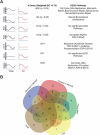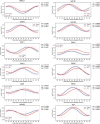This is a preprint.
Evidence for a role of human blood-borne factors in mediating age-associated changes in molecular circadian rhythms
- PMID: 37808824
- PMCID: PMC10557775
- DOI: 10.1101/2023.04.19.537477
Evidence for a role of human blood-borne factors in mediating age-associated changes in molecular circadian rhythms
Update in
-
Evidence for a role of human blood-borne factors in mediating age-associated changes in molecular circadian rhythms.Elife. 2024 Nov 1;12:RP88322. doi: 10.7554/eLife.88322. Elife. 2024. PMID: 39485282 Free PMC article.
Abstract
Aging is associated with a number of physiologic changes including perturbed circadian rhythms; however, mechanisms by which rhythms are altered remain unknown. To test the idea that circulating factors mediate age-dependent changes in peripheral rhythms, we compared the ability of human serum from young and old individuals to synchronize circadian rhythms in culture. We collected blood from apparently healthy young (age 25-30) and old (age 70-76) individuals at 14:00 and used the serum to synchronize cultured fibroblasts. We found that young and old sera are equally competent at initiating robust ~24h oscillations of a luciferase reporter driven by clock gene promoter. However, cyclic gene expression is affected, such that young and old sera promote cycling of different sets of genes. Genes that lose rhythmicity with old serum entrainment are associated with oxidative phosphorylation and Alzheimer's Disease as identified by STRING and IPA analyses. Conversely, the expression of cycling genes associated with cholesterol biosynthesis increased in the cells entrained with old serum. Genes involved in the cell cycle and transcription/translation remain rhythmic in both conditions. We did not observe a global difference in the distribution of phase between groups, but found that peak expression of several clock-controlled genes (PER3, NR1D1, NR1D2, CRY1, CRY2, and TEF) lagged in the cells synchronized ex vivo with old serum. Taken together, these findings demonstrate that age-dependent blood-borne factors affect circadian rhythms in peripheral cells and have the potential to impact health and disease via maintaining or disrupting rhythms respectively.
Figures




References
-
- Monk T. H., Buysse D. J., Reynolds C. F. & Kupfer D. J. Inducing jet lag in older people: Adjusting to a 6-hour phase advance in routine. Experimental Gerontology 28, 119–133 (1993). - PubMed
-
- Monk T. H., Buysse D. J., Carrier J. & Kupfer D. J. Inducing jet-lag in older people: Directional asymmetry. Journal of Sleep Research 9, 101–116 (2000). - PubMed
Publication types
Grants and funding
LinkOut - more resources
Full Text Sources
